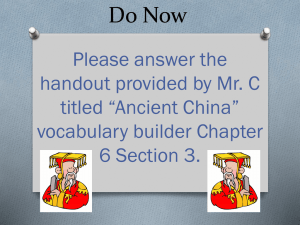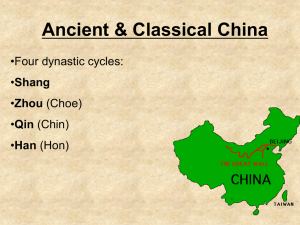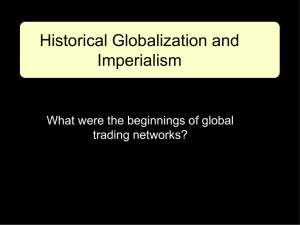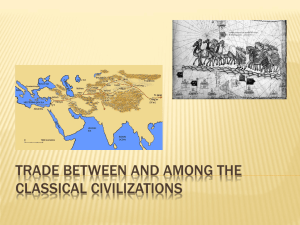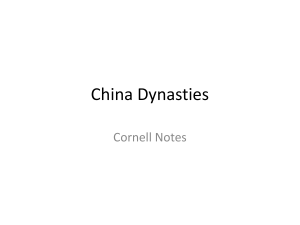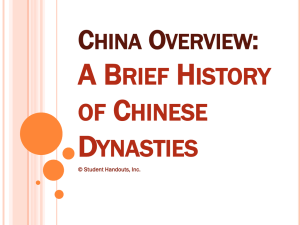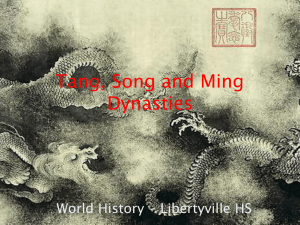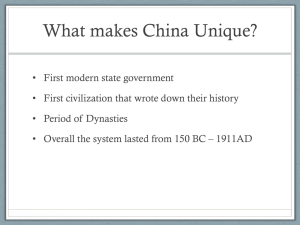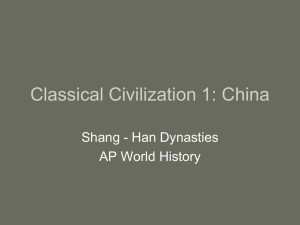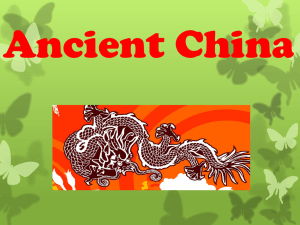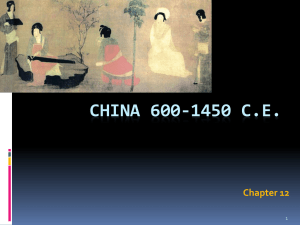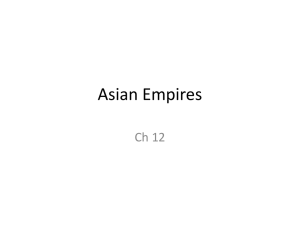China Through the Ages - Texas Council on Economic Education
advertisement
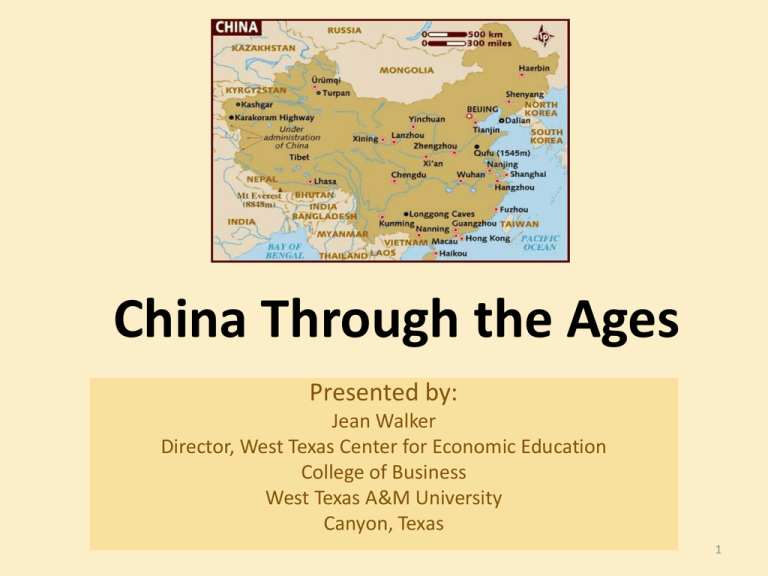
China Through the Ages Presented by: Jean Walker Director, West Texas Center for Economic Education College of Business West Texas A&M University Canyon, Texas 1 • This powerpoint was used in a workshop at ESC 16 in Amarillo on June 26, 2012. It includes Lessons 7, 13, and 17 from the Focus: Middle School World History publication from CEE. • Many slides are procedural directions for teachers. • Any teacher can use the powerpoint as a springboard for teaching the lessons with some modifications. 2 China Through the Ages • Lesson 7: The Silk Road (Han Dynasty) • Lesson 13: Paper Money of the Sung, Yuan, and Ming Dynasties • Lesson 17: Why Didn’t China Discover the New World? 3 World History • (1) History. The student understands traditional historical points of reference in world history. The student is expected to: – (A) identify major causes and describe the major effects of the following events from 8000 BC to 500 BC: the development of agriculture and the development of the river valley civilizations; – (B) identify major causes and describe the major effects of the following events from 500 BC to AD 600: the development of the classical civilizations of Greece, Rome, Persia, India (Maurya and Gupta), China (Zhou, Qin, and Han), and the development of major world religions; – (C) identify major causes and describe the major effects of the following important turning points in world history from 600 to 1450: the spread of Christianity, the decline of Rome and the formation of medieval Europe; the development of Islamic caliphates and their impact on Asia, Africa, and Europe; the Mongol invasions and their impact on Europe, China, India, and Southwest Asia; – (D) identify major causes and describe the major effects of the following important turning points in world history from 1450 to 1750: the rise of the Ottoman Empire, the influence of the Ming dynasty on world trade, European exploration and the Columbian Exchange, European expansion, and the Renaissance and the Reformation; 4 World History • (3) History. The student understands the contributions and influence of classical civilizations from 500 BC to AD 600 on subsequent civilizations. The student is expected to: – (A) describe the major political, religious/philosophical, and cultural influences of Persia, India, China, Israel, Greece, and Rome, including the development of monotheism, Judaism, and Christianity; – (B) explain the impact of the fall of Rome on Western Europe; and – (C) compare the factors that led to the collapse of Rome and Han China. 5 World History • (4) History. The student understands how, after the collapse of classical empires, new political, economic, and social systems evolved and expanded from 600 to 1450. The student is expected to: – – – – – – – – – – – (A) explain the development of Christianity as a unifying social and political factor in medieval Europe and the Byzantine Empire; (B) explain the characteristics of Roman Catholicism and Eastern Orthodoxy; (C) describe the major characteristics of and the factors contributing to the development of the political/social system of feudalism and the economic system of manorialism; (D) explain the political, economic, and social impact of Islam on Europe, Asia, and Africa; (E) describe the interactions among Muslim, Christian, and Jewish societies in Europe, Asia, and North Africa; (F) describe the interactions between Muslim and Hindu societies in South Asia; (G) explain how the Crusades, the Black Death, the Hundred Years' War, and the Great Schism contributed to the end of medieval Europe; (H) summarize the major political, economic, and cultural developments in Tang and Song China and their impact on Eastern Asia; (I) explain the development of the slave trade; (J) analyze how the Silk Road and the African gold-salt trade facilitated the spread of ideas and trade; and (K) summarize the changes resulting from the Mongol invasions of Russia, China, and the Islamic world. 6 World History • (7) History. The student understands the causes and impact of European expansion from 1450 to 1750. The student is expected to: – (A) analyze the causes of European expansion from 1450 to 1750; – (B) explain the impact of the Columbian Exchange on the Americas and Europe; – (C) explain the impact of the Atlantic slave trade on West Africa and the Americas; – (D) explain the impact of the Ottoman Empire on Eastern Europe and global trade; – (E) explain Ming China's impact on global trade 7 World History • (13) History. The student understands the impact of major events associated with the Cold War and independence movements. The student is expected to: – (A) summarize how the outcome of World War II contributed to the development of the Cold War; – (B) summarize the factors that contributed to communism in China, including Mao Zedong's role in its rise, and how it differed from Soviet communism; – (C) identify the following major events of the Cold War, including the Korean War, the Vietnam War, and the arms race; – (D) explain the roles of modern world leaders, including Ronald Reagan, Mikhail Gorbachev, Lech Walesa, and Pope John Paul II, in the collapse of communism in Eastern Europe and the Soviet Union; 8 Dynasties of China • • • • • • • • • • • • • • • • Neolithic Cultures Xia Dynasty Shang Dynasty Zhou Dynasty Qin Dynasty Han Dynasty Six Dynasties Period Sui Dynasty Tang Dynasty Five Dynasties Period Song Dynasty Yuan Dynasty Ming Dynasty Qing Dynasty Republic Period People’s Republic of China 10,000 – 2,000 B.C. 2100 – 1600 B.C. 1600 – 1050 B.C. writing, bronze, walled cities 1046 - 256 B.C. Confucius 221-206 B.C. standard weights and measures 206 B.C. – 220 A.D. civil service exams 220 – 589 empire fragmented; Buddahism 581 – 618 China reunified 618 – 906 cultural flowering 907 - 960 960 – 1279 maritime trade/commerce 1279 – 1368 Mongol conquest 1368 – 1644 vibrant literary scene 1644 – 1912 prosperity; population increase 1912 – 1949 Nationalist govt. 1949 – present Communist govt; cultural revol. 9 “The Dynasties Song” This "dynasties song," sung to the tune of "Frère Jacques," can help students remember the major Chinese dynasties in chronological order. Shang, Zhou, Qin, Han Shang, Zhou, Qin, Han Sui, Tang, Song Sui, Tang, Song Yuan, Ming, Qing, Republic Yuan, Ming, Qing, Republic Mao Zedong Mao Zedong — Courtesy of the teachers on the College Board AP-World History Listserv 10 Lesson 7: The Silk Road Activity 7.1: During the Han Dynasty in China, 206 B.C. - 220 A.D. , China went through a period of stability that resulted in increased trade between the cities of the region and then spread to regions that are now India, Pakistan, Iraq and Iran, and as far as the Mediterranean Sea to Rome. 11 The Silk Road • The Romans wanted silk for clothing and decoration. • Silk was profitable for producers in China. 12 The Silk Road • The Silk Road connected the West with the East through cities like Alexandria Eschate (in current Tajikistan) founded by Alexander the Great in 329 B.C. • The Han Dynasty’s capital Chang’an (now Xi’an) in central China was the 13 main city at the eastern end of the Silk Road. The Silk Road • The Silk Road was actually a series of roads extending north and south. • People used these roads to carry goods between Rome and Chang’an. • At times, sea routes carried this trade, as maritime technologies improved or when violence threatened land traders. • When pirates and other perils faced the merchants on the sea routes, trade increased on the land routes. 14 The Silk Road • Along the routes, different regions offered dates, copper, herbs, and finished products. • China offered the magnetic compass, silk, gunpowder, and ceramics. • All along the trade routes, gold was a common form of money for trading. 15 The Silk Road • The Silk Road spread cultures: ideas, languages, customs, and scientific knowledge. • It also spread the bubonic plague, which resulted in the Black Death in Europe. • The amount of trade and the price of goods changed depending on new technologies, changing consumer wants, and competitive forces. • The end of the ancient Silk Road began with the disintegration of the Mongol Empire in the late 1300s. • In the late Middle Ages, land trade declined as sea routes expanded with the use of new navigation technologies. Black Death in Europe 16 LESSON 7 – THE SILK ROAD Silk Road Cities and Products Produced in Each City Chang’an Silk Khotan Jade Kashgar Herbs Alexandria Eschate Copper Damascus Dates Rome Gold 17 FOCUS MIDDLE SCHOOL WORLD HISTORY © COUNCIL FOR ECONOMIC EDUCATION, NEW YORK, NY LESSON 7 – THE SILK ROAD Silk Road Cities and Products Procedures for Activity 7.4: (Page 104) • Explain students will trade along the Silk Road by bartering. • Traveling the Silk Road was rough and traders faced obstacles including taxation and thieves. • They also had to pay their workers. • Look at the next slide. The columns of the table show the amount of one good it takes to barter for units of another good. – For example, it takes four gold coins to buy four bolts of silk. – It takes 8 copper coins to buy 8 jade boxes. – Since the column is for Alexandria Eschate, it gives relative prices for all goods in Alexandria Eschate. 18 FOCUS MIDDLE SCHOOL WORLD HISTORY © COUNCIL FOR ECONOMIC EDUCATION, NEW YORK, NY LESSON 7 – THE SILK ROAD Page 104 Bartering along the Silk Road Good West <--------------- Cities ---------------> East Rome Damascus Alexandria Eschate Gold (coins) 4 Dates (baskets) 8 Copper (coins) 8 Herbs (baskets) 16 Jade (boxes) 8 Silk (bolts) 4 Kashgar Khotan Chang'an 32 19 FOCUS MIDDLE SCHOOL WORLD HISTORY © COUNCIL FOR ECONOMIC EDUCATION, NEW YORK, NY LESSON 7 – THE SILK ROAD Silk Road Cities and Products Procedures for Activity 7.4: (Page 104) • Tell students that as a good is moved from city to city, half of the good is lost to traders, thieves, and taxes. • If 32 silk bolts begin in Chang’an and are sent west, only 16 bolts arrive in Khotan, then 8 bolts in Kasgar, etc. • Have students fill out the activity starting with silk from Chang’an. Use the colored blocks as starting points and then reduce by half as goods move east or west. • It should look like the next slide. 20 FOCUS MIDDLE SCHOOL WORLD HISTORY © COUNCIL FOR ECONOMIC EDUCATION, NEW YORK, NY LESSON 7 – THE SILK ROAD Bartering along the Silk Road - Key Good Gold (coins) Dates (baskets) Copper (coins) Herbs (baskets) Jade (boxes) Silk (bolts) West Cities East Rome Damascus Alexandria Eschate Kashgar Khotan Chang'an 16 8 4 2 1 .5 8 16 8 4 2 1 2 4 8 4 2 1 4 8 16 32 16 8 2 4 8 16 32 16 1 2 4 8 16 32 21 FOCUS MIDDLE SCHOOL WORLD HISTORY © COUNCIL FOR ECONOMIC EDUCATION, NEW YORK, NY LESSON 7 – THE SILK ROAD Silk Road Cities and Products Procedures for Activity 7.4: (Page 104 - 105) • After students have filled out the grid, have them answer the questions in Part I and Part II on page 105.(You can download copies of pages 104 and 105 on the book’s website.) • Answers for Part I: – – – – 1. 2. 3. 4. – 5. Kashgar, 32 16 gold coins 1 gold coin Rome. As the silk travels further, it becomes more costly. Also, gold is produced in Rome, so it is not very costly. Chang’an, 64 bolts of silk. Relative prices depend upon many factors in a bartering (trading) situation. 22 FOCUS MIDDLE SCHOOL WORLD HISTORY © COUNCIL FOR ECONOMIC EDUCATION, NEW YORK, NY LESSON 7 – THE SILK ROAD Silk Road Cities and Products Procedures for Activity 7.4: • Answers for Part II: – – – – 1. 2. 3. 4. (Page 104-105) Good trade Bad trade Good trade Bad trade • Answer for Part III: If you travel, you will arrive in Chang’an with 2 gold coins and can buy 128 bolts of silk with the gold. As you travel to Rome, you will lose silk to thieves, taxes, and payments for workers but will end up with 4 bolts of silk worth 16 gold coins each. So you would finish with 64 gold coins. 23 FOCUS MIDDLE SCHOOL WORLD HISTORY © COUNCIL FOR ECONOMIC EDUCATION, NEW YORK, NY Lesson 13: Paper Money of the Sung, Yuan, and Ming Dynasties • The Chinese were the first people to use paper money beginning in the 800s. • The Chinese government began issuing paper money in 1024 A.D. • Beginning that year, only the Chinese government was allowed to issue paper money. • The Chinese continued to use paper money through the Sung dynasty (960–1279), the Yuan dynasty (1279– 1368), and the beginning of the Ming Dynasty (1368– 1644). • Around 1430, the Chinese were the first to stop using paper money. 24 Lesson 13: Paper Money of the Sung, Yuan, and Ming Dynasties • • • • • During the Sung dynasty, paper money and copper coins were both used. The copper coins had a hole in the middle that allowed them to be threaded onto a string. These strings of copper coins could then be transported from place to place and used to buy goods and services. During the Sung dynasty, the paper money issued by the government was in large denominations only. Individual copper coins were used when people wanted to pay for something of small value. However, many copper coins could be exchanged for paper money. Money became more important in China during the Sung dynasty, because the amount of trading that the Chinese did among themselves and with neighboring peoples increased rapidly. SUNG 960 - 1279 • • • • • During the Yuan dynasty, paper money was issued by the government in both large and small denominations. The government during the Yuan period ensured that everyone accepted the paper money in exchange for goods and services. Merchants who refused to accept paper money for payment were punished severely. Counterfeiting—the printing of fake money—was punishable by death. European visitors to China in those days were amazed that the Chinese used paper money that wasn’t backed by silver or gold. Marco Polo visits. Yuan 1279-1368 25 Marco Polo • • • • • • • • One visitor to China was Marco Polo, trader/merchant from Venice. From 1271 to 1295, Marco Polo traveled extensively throughout China. When he returned to Venice, he wrote a book about his travels. One story explained how the Chinese produced paper money. Polo described how the Chinese used the bark of mulberry trees to make paper. When the paper was ready, it was cut into different sizes. The smaller sizes had lower value than the larger sizes. Marco Polo explained how a number of officials were appointed by the Yuan emperor to supervise the production of the paper money. These officials would sign each piece of paper money and the chief official would stamp the emperor’s seal on. In this way, each piece of paper money was marked to indicate that it was authentic government money (legal tender). Marco Polo also described how everyone in China was willing to accept paper money in exchange for goods and services because they knew that they, in turn, could buy the goods and services with the paper money. The Chinese government had declared that paper money had to be accepted as payment. He described how people could bring their worn-out paper money to the mint to exchange for new paper money. 26 Ming Dynasty ( 1368 -1644) • During the early years of the Ming dynasty, paper money was used extensively. • But, by the beginning of the 1400s, paper money in China had lost most of its value because most people stopped using it. • People stopped using paper money during the Ming dynasty for many reasons. • First, the Ming rulers did not have strict rules and harsh punishments to force people to use paper money and to stop them from printing counterfeits. • Counterfeiting increased during the Ming dynasty and people began to distrust paper money and refuse to accept it in exchange for goods and services. They began to use more silver coins. • As the demand for paper money decreased, so, too did its value. Paper money eventually became practically worthless, so the Ming government stopped issuing it around 1430. 27 Debriefing the Reading: “Paper Money in China” • Marco Polo observed paper money being made in China. What did he see? paper made from mulberry bark & signed by officials • According to Marco Polo, everyone in China was willing to use paper money. Why was this so? govt. declared it “legal tender” • What is legal tender? anything the govt. says must be accepted for payment • During the Sung dynasty, what two forms of money were most common? copper coins and paper money • Which form of money had the largest denominations? paper money • During the Yuan dynasty, what denominations of paper money did the government print? both large and small • What caused the Ming dynasty to stop issuing paper money? paper money lost value and people stopped using it • Why did paper money lose most of its value during the Ming dynasty? counterfeiting became common because it wasn’t harshly punished 28 Trading Activity – 8 teams • Prepare 8 “trading bags” structured as listed on page 199. They also get a shopping bag. What do the goods represent? – Tea bags – tea has been popular in China since the Qin Dynasty (221-206) – Goldfish – represent fish, a food staple for many Chinese for thousands of years – Chopsticks – Chinese have been using chopsticks since the Shang dynasty (16001046 B.C.) – Paper clips – represent the metal tools in use in China since 3100 B.C. • Instructions for students: – Each group should read the trading instructions in their bag. There will be a 10minute trading period. – Each group is told the minimum amount to sell their goods for, but they should sell for as much as possible. – Each group should try to sell all their goods. – Each group is told what they must buy, trying to pay the lowest price possible. They need to buy all the goods and put them in their shopping bag. – Paper money represents strings of copper coins. You must use paper money for buying and selling. If you get caught bartering, all goods will be confiscated and you will be severely punished! 29 Trading Activity – 8 teams • Goal: Sell your goods at the highest price. – Sell all your goods at the highest price. – Buy the goods you need at the lowest price. – Have as much money as possible left over. • 10 minute trading time • Debrief: – Who sold all and bought everything they need? – If not, why? – What happened if you ran out of money to buy things? • Discuss functions and characteristics of money on next three slides. 30 LESSON 13 – PAPER MONEY OF THE SUNG, YUAN, AND MING DYNASTIES Functions of Money Medium of Exchange Money acts as a go-between to make it easier to buy and sell things. Store of Value Money holds its value until people want to exchange it for a good or service. Unit of Account Money serves as a way to measure and compare the value of goods and services in relation to one another. FOCUS MIDDLE SCHOOL WORLD HISTORY © COUNCIL FOR ECONOMIC EDUCATION, NEW YORK, NY 31 Trading Activity - Takeaways • Money has to be accepted by everyone if you offer it for payment. • Buyers and sellers has to be able to make change. • The money has to be physically durable. • The money has to be easy to carry around. • Money has to be scarce and unlikely to lose value. 32 LESSON 13 – PAPER MONEY OF THE SUNG, YUAN, AND MING DYNASTIES Characteristics of Money Acceptable Money must be acceptable to everyone in exchange for goods and services. Divisible Money must be easily divided into small parts (or already in small pieces) so that people can purchase goods and services at any price. Durable Money must be able to withstand the wear and tear of many people using it. Portable Money must be easy to carry. Scarce Money must be hard for people to obtain. Stable in value Money’s value must remain relatively constant over long periods of time. FOCUS MIDDLE SCHOOL WORLD HISTORY © COUNCIL FOR ECONOMIC EDUCATION, NEW YORK, NY 33 Functions of Money Spider Graph • Show the spider graph on the next slide and explain students will use a spider graph to analyze how good an item would be at meeting the functions of money. • Use the next slide to show the two examples—bricks and brussels sprouts • Use a rating scale of 1 or 5 with 1 being best. 34 LESSON 13 – PAPER MONEY OF THE SUNG, YUAN, AND MING DYNASTIES Functions of Money Spider Graph FOCUS MIDDLE SCHOOL WORLD HISTORY © COUNCIL FOR ECONOMIC EDUCATION, NEW YORK, NY 35 LESSON 13 – PAPER MONEY OF THE SUNG, YUAN, AND MING DYNASTIES Spider Graph Examples FOCUS MIDDLE SCHOOL WORLD HISTORY © COUNCIL FOR ECONOMIC EDUCATION, NEW YORK, NY 36 Functions of Money Spider Graph • Give each student a copy of Activity 13.4 and have each student draw one card from the deck made from Activity 13.5, Commodities as Money Cards. • Have each student do a spider graph on their commodity. • Each student then explains what their commodity is, shows their spider graph, and makes a recommendation of the commodity’s suitability to be used as money. • Have the class decide which commodity would be used as money best. 37 Lesson 17: Why Didn’t China Discover the New World? • Ask students to define the word “explorer.” • Why did most explorers in the 1400s reply on government support? Few individuals could finance a trip although the Dutch East India Company was “for profit.” • Why were governments willing to finance explorers? Governments wanted gold, spices, new trade routes, national prestige, new lands, etc. • New navigation technology appeared in the 1400s. (see next two slides) 38 LESSON 17 – WHY DIDN’T CHINA DISCOVER THE NEW WORLD? Sailing Technology Axial Rudder: An axial rudder is a vertical blade at the stern of a vessel that can be used to change direction. Multiple Masts and Sails: A ship with multiple masts and sails can sail better into the wind. Watertight Compartments in Ship Hulls: These compartments prevent water from filling the entire hull of a ship after it has been damaged. FOCUS MIDDLE SCHOOL WORLD HISTORY © COUNCIL FOR ECONOMIC EDUCATION, NEW YORK, NY LESSON 17 – WHY DIDN’T CHINA DISCOVER THE NEW WORLD? Sailing Technology Leeboard: A leeboard is a board that is lowered into the water to prevent a ship from drifting sideways. Magnetic Compass: The magnetic compass allows sailors to determine the direction of the ship when navigators are out of sight of land. The magnetic compass made it possible to find direction at sea. New technology made it safer to sail in stormy seas and to navigate farther from the sight of land. FOCUS MIDDLE SCHOOL WORLD HISTORY © COUNCIL FOR ECONOMIC EDUCATION, NEW YORK, NY Activities 17.1, 17.2, and 17.3 • Divide the class in half and have half read about Explorer A (17.2) and half read about Explorer B (17.3). • Pair students with the separate readings and have them complete Activity 17.1. (answers on next two slides after activities) 41 Explorer A This explorer was seeking a better trade route. After looking to several governments to fund his expedition, he finally found enough financial support from one reluctant government and some private investors. If his expedition succeeded, he would be given many rewards, including the rank of Admiral of the Ocean Sea. He would also be appointed Viceroy and Governor of all the newly colonized lands. In addition, he would receive a portion of all profits from the expedition. Although the rulers financially supported him, they thought that the odds of his success were very low. It was a very risky venture. They were willing to take a chance because success would give them a trade advantage over neighboring countries. The goals of this voyage were exploration, wealth, alternative trade routes, spices, and gold. His first voyage used three ships and a crew of 90 men, the largest ship being 85 feet long, with three masts and a crew of 40. Explorer A’s society developed the following technologies: Axial rudder 12th century Multiple masts and sails 1 4th century Watertight compartments in ship hulls 18th century Leeboard 16th century Magnetic compass 12th century 42 Explorer B This explorer led seven expeditions. The ruler of his country funded his voyages in an effort to make the country more prosperous and powerful than it had been under other rulers. He also wanted to increase his own status as a regional leader. The voyages were also an effort to promote trade and collect tribute (taxes) from neighboring countries. The explorer’s first expedition included over 300 ships with a crew of more than 28,000 men. His fleet included supply ships to carry horses, troop transports, patrol boats, warships, and tankers to carry fresh water. The largest ship in his fleet was reported to be 400 feet long, with nine masts and a crew of over 1,000 men. During his seven expeditions, he explored the coasts of faraway places, visited many ports, and gained prestige for his accomplishments. As a result of his voyages, merchants from his country settled in busy trade centers. Surrounding countries feared this country’s power and strength. The country had little desire to establish colonies; its focus was trade in goods that were not readily available at home. Explorer B’s society developed the following technologies: Axial rudder 1st century Multiple masts and sails 2nd century Watertight compartments in ship hulls 2nd century Leeboard 8th century Magnetic compass 9th–11th centuries 43 LESSON 17 – WHY DIDN’T CHINA DISCOVER THE NEW WORLD? Answers to Activity 17.1 – identify explorers at this point Christopher Columbus Length of longest ship Number of masts of longest ship Number of ships in fleet Number of crew members in fleet 85 feet 3 masts 3 ships 90 400 feet 9 masts 300 ships 28,000 (Explorer A) Zheng He (Explorer B) FOCUS MIDDLE SCHOOL WORLD HISTORY © COUNCIL FOR ECONOMIC EDUCATION, NEW YORK, NY LESSON 17 – WHY DIDN’T CHINA DISCOVER THE NEW WORLD? Resources and Technology When did each of the explorer’s society develop the following technology? Christopher Zheng He Columbus Axial Rudder 12th Century 1st Century Multiple Masts and Sails 14th Century 2nd Century Watertight Compartments in Ship Hulls 18th Century 2nd Century Leeboard 16th Century 8th Century Magnetic Compass 12th Century 9-11th Century Temple, Robert K. G., and Joseph Needham. The Genius of China: 3,000 Years of Science, Discovery, and Invention. New York: Simon and Schuster, 1986. FOCUS MIDDLE SCHOOL WORLD HISTORY © COUNCIL FOR ECONOMIC EDUCATION, NEW YORK, NY Activity 17.4 – Zheng He and Chinese Exploration Between 1405 and 1433 C.E., the Chinese government sent seven naval expeditions south and west to India, Persia, Arabia, and Africa. The leader of these voyages was Zheng He, who sailed most of these voyages during the reign of Emperor Yung-lo (1403–1425). Many of these expeditions included several hundred ships and thousands of sailors and soldiers. After 1433, the Chinese government launched no further naval expeditions. In 1436, the emperor forbade the building of ships for overseas voyages. Forty years later, the government destroyed the records of the voyages of Zheng He. While Spanish and Portuguese explorers claimed the lands of Central and South America, the Chinese withdrew from the seas. Why did China not follow up on its technological superiority? There are several theories listed on the next slide: 46 Activity 17.4 – Zheng He and Chinese Exploration • The spending of Yung-lo’s government greatly exceeded the tax revenue that could be collected. Although the Chinese system of taxation was the most advanced in the world, even the emperor could not continue to fund massive fleets on the scale of those used by Zheng He. • In the mid-1400s, Mongols began frequent attacks on China’s northern border. The attacks may have forced China to devote more resources to the defense of the border. • Neo-Confucian scholars held many important government posts. Neo-Confucian philosophy encouraged the suppression of desire for worldly things. Trade and profits were held in contempt. Particularly after Yung-lo’s death, the influence of the NeoConfucian scholars grew.. 47 Activity 17.4 – Zheng He and Chinese Exploration • Some of the Chinese people at the time were concerned about the influence that foreign goods and ideas had on Chinese culture •All of these reasons changed the incentives for exploration. Zheng He is said to have died returning from his final expedition in 1433. “We . . . have beheld in the ocean huge waves like mountains rising sky high, and we have set eyes on barbarian regions far away hidden in a blue transparency of light vapors, while our sails, loftily unfurled like clouds day and night, continued their course [as rapidly as] a star, traversing those savage waves as if we were treading a public thoroughfare.” – Zheng He, 1432 48 LESSON 17 – WHY DIDN’T CHINA DISCOVER THE NEW WORLD? Definition Incentive: Any reward or benefit, such as money, advantage or good feeling, that motivates people to do something. What were the main incentives for Columbus? What were the main incentives for Zheng He? What disincentives did Zheng He eventually have? What is the most important—better technology or superior incentives? FOCUS MIDDLE SCHOOL WORLD HISTORY © COUNCIL FOR ECONOMIC EDUCATION, NEW YORK, NY
